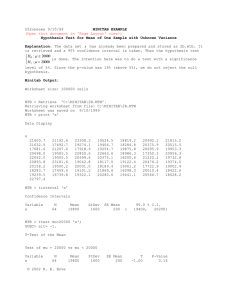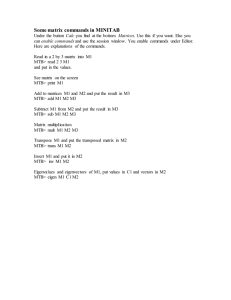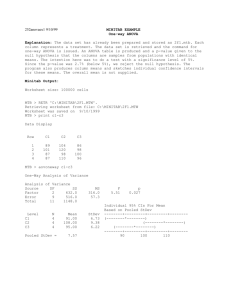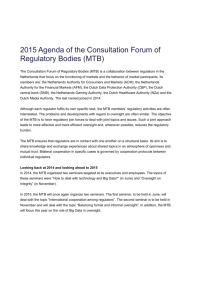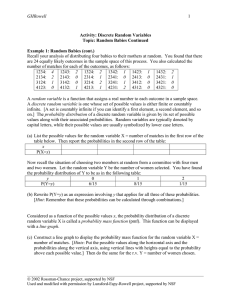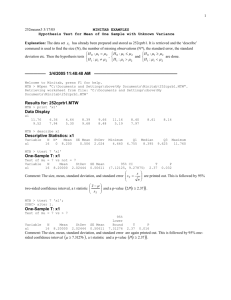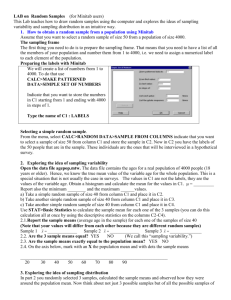GHRowell
advertisement
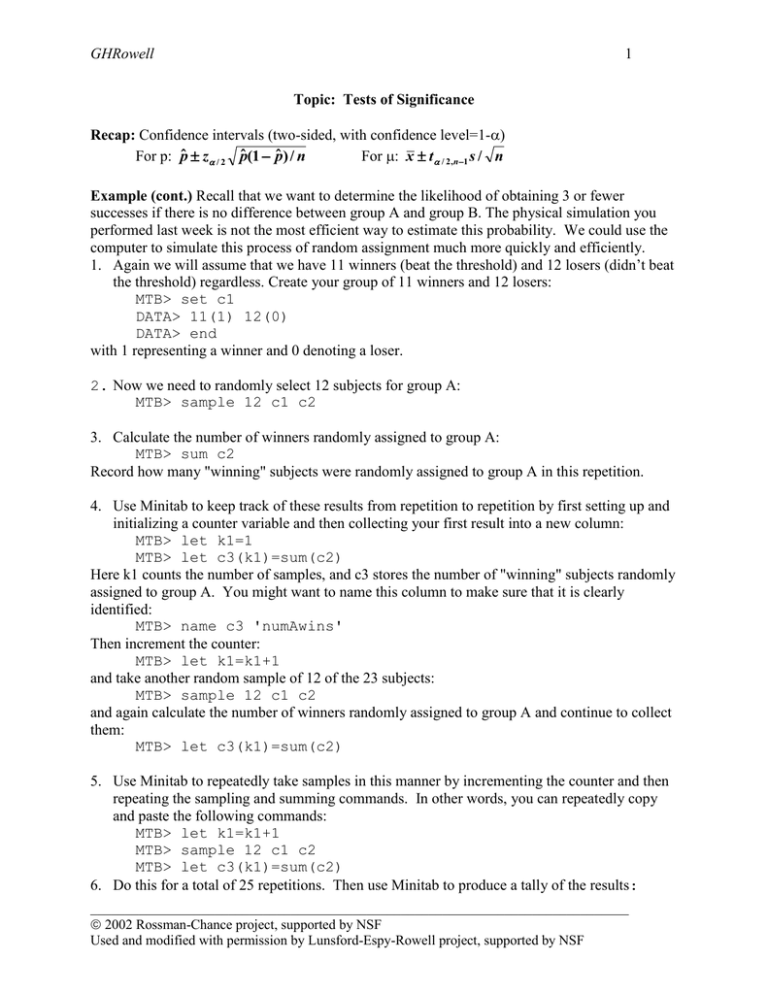
GHRowell 1 Topic: Tests of Significance Recap: Confidence intervals (two-sided, with confidence level=1-) For p: pˆ z / 2 pˆ (1 pˆ ) / n For : x t / 2,n1 s / n Example (cont.) Recall that we want to determine the likelihood of obtaining 3 or fewer successes if there is no difference between group A and group B. The physical simulation you performed last week is not the most efficient way to estimate this probability. We could use the computer to simulate this process of random assignment much more quickly and efficiently. 1. Again we will assume that we have 11 winners (beat the threshold) and 12 losers (didn’t beat the threshold) regardless. Create your group of 11 winners and 12 losers: MTB> set c1 DATA> 11(1) 12(0) DATA> end with 1 representing a winner and 0 denoting a loser. 2. Now we need to randomly select 12 subjects for group A: MTB> sample 12 c1 c2 3. Calculate the number of winners randomly assigned to group A: MTB> sum c2 Record how many "winning" subjects were randomly assigned to group A in this repetition. 4. Use Minitab to keep track of these results from repetition to repetition by first setting up and initializing a counter variable and then collecting your first result into a new column: MTB> let k1=1 MTB> let c3(k1)=sum(c2) Here k1 counts the number of samples, and c3 stores the number of "winning" subjects randomly assigned to group A. You might want to name this column to make sure that it is clearly identified: MTB> name c3 'numAwins' Then increment the counter: MTB> let k1=k1+1 and take another random sample of 12 of the 23 subjects: MTB> sample 12 c1 c2 and again calculate the number of winners randomly assigned to group A and continue to collect them: MTB> let c3(k1)=sum(c2) 5. Use Minitab to repeatedly take samples in this manner by incrementing the counter and then repeating the sampling and summing commands. In other words, you can repeatedly copy and paste the following commands: MTB> let k1=k1+1 MTB> sample 12 c1 c2 MTB> let c3(k1)=sum(c2) 6. Do this for a total of 25 repetitions. Then use Minitab to produce a tally of the results: ______________________________________________________________________________ 2002 Rossman-Chance project, supported by NSF Used and modified with permission by Lunsford-Espy-Rowell project, supported by NSF GHRowell 2 MTB> tally c3 and to produce a dotplot and histogram of the distribution: MTB> %Dotplot c3 (It may be easier to choose "Dotplot" from the "Graph" menu.) MTB> hist c3 7. Is this distribution similar to what you found with the card simulation? In how many of these 25 random assignments were 3 or fewer winners assigned to group A? While this Minitab simulation is more efficient than shuffling and dealing cards, we can make it run much more quickly by writing a macro (a series of Minitab commands). I have pasted the three lines into a file called “friendly.mtb” (You can open this file in Word to verify its contents) which we can execute many, many times. 8. To run this macro, first re-initialize the counter and clear the output columns: MTB> let k1=1 MTB> erase c2 c3 Then select File> Other Files> Run an Exec…, tell it to execute 1000 times, click on “Select file.” Click in the arrow at the top next to “Data” and then select Desktop in the pull-down menu. Then double click on Statfolder, then Chance, then Stat322, then friendly.mtb. 9. When the macro has finished running, ask Minitab for a tally and a histogram of the results (remember that the results represent the number of winners randomly assigned to group A under the assumption that the observer’s incentive has no effect). Record the distribution in the table: 0 1 2 3 4 5 6 7 8 9 10 11 Tally (d) In how many of these 500 repetitions were the results as extreme as in the researchers’ actual data? Are the sample data pretty unlikely to occur by chance variation alone if the observer’s incentive had no effect? Do the sample data provide reasonably strong evidence in favor of the researchers’ conjecture? Explain. The reasoning process of this activity typifies that of statistical tests of significance. One starts by assuming that there is no difference between the two experimental groups and then investigates how often the observed data would occur if nothing more than the random assignment of subjects to groups were involved. If the answer is that the observed data are quite unlikely to arise due to chance, then the data provide evidence against the assumption of no difference between the groups, thus supporting the hypothesis that the treatment does indeed have an effect. ______________________________________________________________________________ 2002 Rossman-Chance project, supported by NSF Used and modified with permission by Lunsford-Espy-Rowell project, supported by NSF GHRowell 3 Setting up a test of significance 1. State parameter(s) of interest 2. State two competing hypotheses about population H0: null hypothesis dull hypothesis Ha: alternative hypothesis the one you actually hope to demonstrate We will initially assume H0 is true unless we have strong evidence against it. Example – Friendly Observers Parameter(s): H0: Ha: Example In the 1980’s, many companies experimented with “flex-time,” allowing employees to choose their schedules within broad limits set by management. Among other things, flex-time was supposed to reduce absenteeism. Suppose one firm knows that in the past few years, employees have averaged 6.3 days off from work (with standard deviation 2.9 days). This year, the firm introduces flex-time. Management chooses a simple random sample of 100 employees to follow, and at the end of the year these employees average 5.5 days off from work. Does flextime reduce absenteeism? Parameter(s): H0: Ha: 3. Compare the observed result to the hypothesized result = test statistic 4. Calculate the probability of observing sample data that extreme if null hypothesis is true = p-value 5. Decide whether the p-value is small enough to convince you the sample result didn’t just happen by chance alone. Example (cont.) If = 6.3, how should the distribution of sample means behave? Level of Significance, = cut-off value If p-value < , reject H0, result is “statistically significant” If p-value > , fail to reject H0, result is “not statistically significant” controls how often we falsely reject the null hypothesis Type I Error = reject H0 when H0 is true = P(Type I Error) ______________________________________________________________________________ 2002 Rossman-Chance project, supported by NSF Used and modified with permission by Lunsford-Espy-Rowell project, supported by NSF
